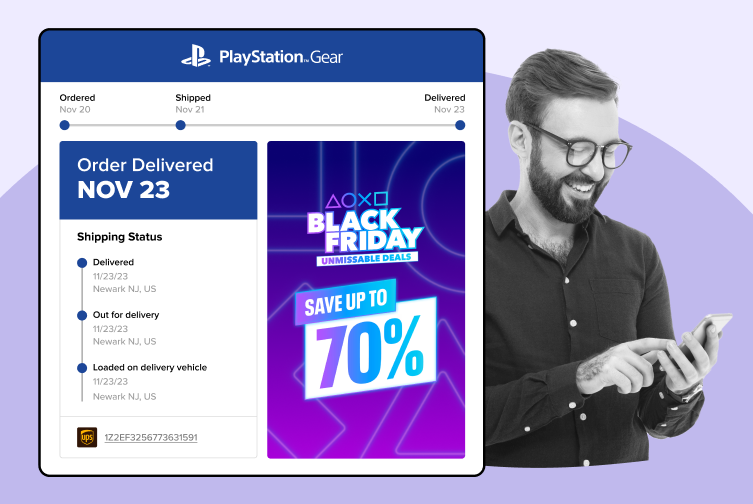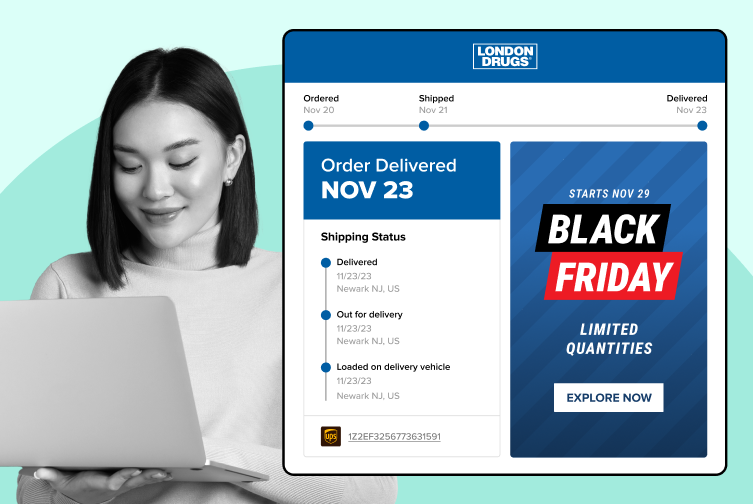
How to Build a Scalable Enterprise Returns Management System
Discover effective strategies for managing returns in retail. Enhance customer satisfaction while minimizing costs. Read the article for practical insights.
Shipping, Tracking & Notifications
Boost customer experience and reduce support tickets
Realtime order and shipment tracking
Proactive order and shipping notifications
AI-Enhanced Discounted Labels
Predictive pre-purchase estimated delivery dates
Self-Serivce branded order tracking
Effortless experience delivered
Identify and Resolve Order Issues
Realtime order and shipment tracking
Make returns profitable and delight customers
Flexibility to define any return destinations & conditions
Simplify returns for your customers and team
Incentivize exchanges over returns
Returns management made easy for your team
Returns management made easy for your team
Easy claims and smart upsells
Understand why your customers are returning
In-Store & Curbside Pickup
Unify the online and the in-store experience
Hassle-free pickup experience for customers
In-Store dashboard to keep operations streamlined
In-Store and Online orders unified
Drive foot-traffic to your stores
Shipping, Tracking & Notifications
Boost customer experience and reduce support tickets
Realtime order and shipment tracking
Proactive order and shipping notifications
AI-Enhanced Discounted Labels
Predictive pre-purchase estimated delivery dates
Self-Serivce branded order tracking
Effortless experience delivered
Identify and Resolve Order Issues
Realtime order and shipment tracking
Make returns profitable and delight customers
Flexibility to define any return destinations & conditions
Simplify returns for your customers and team
Incentivize exchanges over returns
Returns management made easy for your team
Returns management made easy for your team
Understand why your customers are returning
In-Store & Curbside Pickup
Unify the online and the in-store experience
Hassle-free pickup experience for customers
In-Store Dashboard to keep operations streamlined
In-Store and Online orders unified
Drive foot-traffic to your stores
Boost customer experience and reduce support tickets
Realtime order and shipment tracking
Proactive order and shipping notifications
AI-Enhanced Discounted Labels
Predictive pre-purchase estimated delivery dates
Self-Serivce branded order tracking
Effortless experience delivered
Make returns profitable and delight customers
Flexibility to define any return destinations & conditions
Simplify returns for your customers and team
Incentivize exchanges over returns
Returns management made easy for your team
Equip your team for precise return checks.
Easy claims and smart upsells
Understand why your customers are returning
Unify the online and the in-store experience
Hassle-free pickup experience for customers
In-Store Dashboard to keep operations streamlined
In-Store and Online orders unified
Drive foot-traffic to your stores
Find the answer to all your questions
Take a step by step trip through our functionality to see how we can improve your ecommerce processes.
Explore the most comon questions about WeSupply
Calculate the ROI that WeSupply can bring you
Read actionable articles on how to optimize your post-purchase experience and decrease support tickets
Get inspired by stories of how our customers implemented an effortless post-purchase experience
Wondering if WeSupply is a good fit for you? Read through our use cases to see how we can help you increase conversion & improve CX!
A Deep Dive into Top Companies' Order Tracking & Returns Strategy
Find the answer to all your questions
Explore the most comon questions about WeSupply
Calculate the ROI that WeSupply can bring you
Request a no strings attached review of your current shopping experience and missed conversion opportunities
Take a step by step trip through our functionality to see how we can improve your ecommerce processes.
Read actionable articles on how to optimize your post-purchase experience and decrease support tickets
Get inspired by stories of how our customers implemented an effortless post-purchase experience
A Deep Dive into Top Companies' Order Tracking & Returns Strategy
Wondering if WeSupply is a good fit for you? Read through our use cases to see how we can help you increase conversion & improve CX!

Returns are inevitable in ecommerce, especially at the enterprise scale. Ecommerce businesses, particularly at the enterprise level, face unique challenges in managing returns, such as handling high volumes, online return processes, and fraud prevention. Customers may receive items that don’t fit, arrive damaged, or simply fail to meet expectations. A well-structured Return Merchandise Authorization (RMA) process ensures that returns are handled efficiently while protecting margins and maintaining customer trust.
By investing in reliable, timely, and personalized shipping options, ecommerce businesses can create a positive customer experience that not only meets but exceeds customer expectations.
For large enterprises, RMA is not just an operational step, but a core part of the customer experience and supply chain strategy. It provides order visibility, streamlines reverse logistics, and ensures financial accuracy. Whether in B2C or B2B, a strong RMA system helps you handle volume while enhancing loyalty.
In this guide, we’ll explore how to design an RMA process for enterprise-scale ecommerce that balances efficiency, profitability, and customer satisfaction.
Returns are expensive. The National Retail Federation (NRF) reported that in 2023, 16.5% of all U.S. retail sales were returned, totaling $743 billion. Of that, nearly $100 billion was lost to return fraud. For enterprises managing thousands of SKUs and millions of customers, weak RMA processes can quickly turn into margin erosion. Manual or poorly designed return processes are often error prone, increasing the risk of mistakes and losses.
But returns are also an opportunity. Research shows that 92% of consumers will buy again if the return experience is easy. A fast, transparent RMA builds trust and encourages repeat purchases. Instead of treating returns as a cost center, enterprises can use them to drive long-term loyalty.
Traditional views treat returns as sunk costs. But leading enterprises now treat returns as a loyalty and retention lever. By offering flexible returns, automating processing, and integrating systems, businesses can turn returns into a revenue-saving mechanism.
Consider Amazon. Their RMA process is built into self-service, instant label generation, and proactive refunds for some items. These systems are designed for efficient handling of returns, reducing manual effort and improving customer satisfaction through timely and transparent communication. Customers come back because the hassle is low. The cost of processing is offset by higher lifetime value (CLV). That’s the model enterprises should aim for.
An effective RMA starts with policy clarity. Customers and employees must understand:
Eligibility: Which products can be returned.
Timeframes: Deadlines for initiating returns.
Conditions: Packaging, tags, or unopened requirements.
Return instructions: Step-by-step guidance on how to return products.
Enterprises often need regional or channel-specific adjustments. A return window for apparel in the U.S. may differ from electronics in Europe. B2B policies may involve restocking fees or inspections that B2C doesn’t.
Fraud prevention should also be embedded in the policy. Serial number tracking, photo requirements, and restrictions on high-risk items can deter abuse without alienating customers. Transparency is key if customers understand the rules, they’re less likely to challenge them.
The RMA process short for Return Merchandise Authorization or Return Material Authorization is the backbone of managing product returns in enterprise-scale ecommerce. This systematic approach ensures that every return is handled efficiently, from the moment a customer initiates a return request to the final resolution. The RMA process begins when a customer, dissatisfied with a purchase or facing product defects or warranty claims, submits a return request through the ecommerce platform or customer support. At this stage, the customer provides all necessary details, such as product information, order number, and the reason for the return.
Once the return process is initiated, the RMA system verifies the eligibility of the merchandise authorization or material authorization based on company policies. If the return meets the criteria, the RMA request is approved, and the customer receives instructions often including an RMA number and shipping label to send the product back. The returned item is then inspected to confirm the reported issue, whether it’s a defect, damage, or another reason. After inspection, the return is processed according to the company’s guidelines, which may involve issuing a refund, replacement, or repair.
An efficient RMA process is essential for enhancing customer satisfaction, as it reduces manual errors, speeds up processing, and minimizes the risk of RMA fraud. By managing product returns systematically, enterprises can maintain customer trust, protect margins, and ensure that inventory and financial records remain accurate. Ultimately, a well-designed RMA process not only resolves customer issues but also strengthens the overall returns management strategy.
At scale, the customer-facing side of returns is just as important as internal processing. Today’s shoppers expect self-service options. A strong enterprise RMA system should allow customers to:
The first step in the RMA process is for customers to submit customer requests for returns through the appropriate channel.
Initiate returns online or via mobile apps.
Upload photos of defective or damaged products.
Instantly generate return labels.
Track status in real time.
Omnichannel options matter too. Customers may want to drop items off in-store, use lockers, or ship them cross-border. Enterprises like Walmart and Zara provide multiple return paths, giving customers flexibility and reducing friction.
Most importantly, communication should be proactive. If an RMA number is issued, customers should receive clear instructions via email or SMS, including packaging requirements and estimated timelines.
The authorization stage is critical. It ensures that only eligible products enter the return stream, preventing unnecessary costs.
Steps typically include:
Customer submits return request (via portal or form). The customer fills out an RMA form, providing all necessary customer information for verification.
System checks eligibility (date, product, condition).
Approval or denial is issued, with RMA number. Formal approval is required before the return can proceed.
Return shipping label is generated if approved.
Automating this process reduces manual errors and speeds up approvals. For example, enterprise RMA software can instantly approve common returns (like apparel within 30 days) while flagging high-risk cases (like expensive electronics).
Clear communication at this stage sets customer expectations. Delays or confusion can quickly erode trust.
Turn returns into a seamless, profitable experience for your customers
Book a quick call with our experts to see how WeSupply can simplify your RMA process and turn returns into a seamless, customer-friendly experience.
At enterprise scale, automation is not optional. Manually reviewing thousands of returns per day leads to errors and delays.
Modern RMA systems integrate with:
ERP (Enterprise Resource Planning) to update inventory and financial records.
CRM (Customer Relationship Management) to track customer interactions.
WMS (Warehouse Management Systems) to optimize reverse logistics.
Automation can handle approvals, label generation, refund initiation, and notifications. Automated systems can process RMA requests in real time, reducing delays and manual intervention. AI can add another layer by detecting fraud, analyzing patterns, and even suggesting root causes of returns.
McKinsey estimates that retailers using data-driven returns management cut costs by 15–25% while improving satisfaction. Efficient returns management relies on integrated systems and automated workflows to streamline the entire process. For enterprises, integration and automation are the backbone of scalable RMA.
Once products are returned, warehouses must process them efficiently. Tracking and managing returned products is essential for quality control and inventory accuracy. Reverse logistics is complex products can’t just be placed back on shelves. They require inspection, sorting, and routing.
Returned items may go to one of four categories:
Restock: Items in new condition.
Refurbish/Repair: Electronics or equipment.
Salvage: Parts recovery.
RTV (Return to Vendor): Items that go back to suppliers.
Enterprises must ensure real-time inventory updates so that returned stock can be resold quickly. Items received through RMA orders may require special handling before being restocked or refurbished. For example, Zara’s fast-fashion model relies on returns being reintegrated into available stock within days.
Efficient warehouse processes, supported by barcode scanning, automation, and reverse logistics software, reduce carrying costs and improve recovery rates.
Speed matters. Customers expect refunds or replacements fast. A survey by Narvar found that 77% of shoppers expect refunds within 5 business days of return shipping. Slow processing damages trust and increases service costs.
Enterprises should design their RMA workflows to process:
Refunds within days, tied directly into accounting systems.
Exchanges automatically, with replacement orders triggered upon receipt of returns.
Store credits instantly, which can encourage future purchases.
Accounting integration ensures accurate financial records while reducing disputes and chargebacks. Communication at every stage reassures customers that their money is safe. Transparent communication is essential to keep customers updated on the status of their returns and refunds, building trust and improving their overall experience.
RMA data is a goldmine for enterprise decision-making. Tracking return rates, reasons, and costs can reveal systemic problems. Enterprises should systematically track return reasons to identify patterns and improve products or processes.
Examples:
High return rates for a SKU may indicate quality issues.
Frequent sizing returns in apparel may point to poor product descriptions.
Return spikes in certain regions may highlight logistics problems.
Predictive analytics can forecast return surges during peak seasons, helping enterprises plan warehouse capacity and staffing. AI-driven insights can also flag fraudulent behavior, like repeated high-value returns from the same account.
Return fraud is a billion-dollar problem. The NRF estimates that return fraud cost U.S. retailers $101 billion in 2023. Common tactics include wardrobing (using items before returning), tag switching, or returning stolen goods.
Enterprises should combine automation and manual checks. Key strategies include:
Tracking serial numbers and customer profiles.
Using a unique identifier, such as an RMA number, to track each return throughout the process.
Setting automated red flags (e.g., frequent high-value returns).
Conducting manual reviews when risks exceed thresholds.
The balance is important. Too much friction can alienate genuine customers, while too little opens the door to abuse. Data-driven fraud prevention ensures efficiency without sacrificing trust.
Global enterprises must adhere to diverse consumer protection laws. The EU, for instance, mandates a 14-day return window for online purchases. Compliance is not optional it builds credibility and avoids fines.
Sustainability is also a growing concern. Returns generate 9.5 billion pounds of landfill waste annually in the U.S. alone. Enterprises are expected to adopt eco-friendly packaging, offer return consolidation options, and explore resale or recycling channels.
Some companies even use carbon tracking tools to measure the environmental footprint of returns, giving customers transparency and reinforcing brand values.
Combat inconvenience with proactivity & self service
Book a quick call with our experts to see how WeSupply can help you make returns easy for your customers with a beautiful, self-service solution that makes their experience easier while also providing new ways to lower costs and earn back revenue.
Enterprises face recurring challenges when scaling RMA processes:
High costs: Automation and streamlined exchanges reduce processing expenses.
Fraud risk: AI-driven red flags manage fraud without punishing honest customers.
Scalability: Cloud-based RMA systems handle peak-season surges.
Customer expectations: Real-time communication keeps customers informed.
Solving these challenges requires both technology and policy improvements. The most successful enterprises iterate constantly based on performance data and customer feedback. Regularly updating and automating RMA procedures is key to overcoming operational challenges.
To ensure that RMA processes run smoothly and deliver maximum value, enterprises should adopt a set of best practices tailored to large-scale operations. Clear communication is fundamental customers should receive timely updates and transparent instructions at every stage of the RMA process, from submitting a return request to receiving a refund or replacement. Proper documentation, including detailed records of customer returns and the reasons behind them, helps prevent misunderstandings and supports efficient processing.
Implementing an effective RMA system with automated notifications and streamlined workflows can significantly reduce manual effort and the risk of errors. Automation not only accelerates the return process but also helps identify and flag potentially fraudulent returns before they impact the business. Enterprises should regularly analyze RMA data to identify trends in customer behavior, such as frequent return reasons or spikes in returns for specific products. These valuable insights enable informed decisions to improve product quality, refine return criteria, and enhance customer satisfaction.
A well-defined RMA policy with clear guidelines on return eligibility, refund options, and replacement or repair procedures is crucial for minimizing customer dissatisfaction and ensuring hassle-free returns. By making these policies easily accessible and straightforward, businesses can foster trust and encourage repeat business.
Integrating RMA processes with enterprise resource planning (ERP) systems and inventory management software further enhances efficiency. This integration provides real-time visibility into returns, streamlines inventory updates, and supports data-driven decision-making. By following these best practices, enterprises can manage returns efficiently, reduce the risk of fraudulent returns, and create a positive customer experience that drives loyalty and repeat purchases.
Managing returns for big online stores can be complicated, but WeSupply makes it easy, fast, and secure. It helps your team handle returns efficiently, reduce mistakes, prevent fraud, and even turn returns into loyal customers.
WeSupply helps you:
Flexible Return Policies: Set where and how items can be returned, so your rules fit your business.
With WeSupply, your store can save time, reduce costs, protect revenue, and create a smoother, happier experience for customers and your team. Book a demo today and transform your returns management.
Designing an enterprise RMA process goes beyond labels and refunds. WeSupply streamlines returns with flexible policies, self-service returns, automated approvals, exchanges, advanced quality control, fraud prevention, partial refunds, multi-user access, barcode scanning, integrations with ERP/3PL/POS, and returns analytics. This approach reduces errors, saves time, protects revenue, and enhances customer trust.
By making returns effortless and insightful, WeSupply turns them into a strategic advantage, helping your enterprise cut costs, improve efficiency, and keep customers loyal even at scale.
1. How can enterprises reduce return fraud?
Enterprises reduce fraud with automated eligibility checks, serial number tracking, AI-driven red flags, and selective manual reviews, balancing efficiency with customer trust.
2. Why is RMA automation critical for large ecommerce stores?
Automation speeds approvals, generates labels instantly, integrates with ERP/CRM/WMS, reduces errors, and enables real-time tracking, allowing enterprises to handle high return volumes efficiently.
3. How can analytics improve RMA management?
Tracking return reasons, costs, and patterns helps identify product issues, optimize policies, forecast peaks, and detect fraud, enabling data-driven decisions and better customer experience.
4. How does WeSupply simplify enterprise returns?
WeSupply automates approvals, label generation, exchanges, partial refunds, and quality checks, reducing errors, saving time, and enhancing customer trust.
5. Can WeSupply prevent return fraud?
Yes, WeSupply detects policy abuse automatically, flags suspicious returns, and maintains multi-user access to secure workflows and protect revenue.
6. How does WeSupply integrate with enterprise systems?
WeSupply connects seamlessly with ERP, POS, and 3PL systems, syncing inventory, returns, and financial records to streamline operations and data tracking.
7. Does WeSupply have an Official Shopify App?
Yes. WeSupply has an Official Shopify App. You can download it and start integrating with your Shopify Store.
8. Does WeSupply have an official Magento extension?
Yes, WeSupply has an official extension for Magento. The WeSupply x Magento integration allows for automating order tracking experiences, reducing customer inquiries, automating shipping email and SMS notifications, and providing a fully branded order tracking experience
9. Does WeSupply have an official BigCommerce App?
Yes, WeSupply has an official BigCommerce App. You can integrate WeSupply with your BigCommerce store to improve your post-purchase customer experience.
Learn How To Create Successful Post Purchase Email Campaigns
Build an effective post-purchase email flow that helps you increase customer satisfaction and drive revenue growth!

Discover effective strategies for managing returns in retail. Enhance customer satisfaction while minimizing costs. Read the article for practical insights.

Learn effective strategies for handling shipping exceptions and keeping customers informed. Enhance your shipping process today!

Discover practical strategies to reduce shipping costs for your business. Boost your bottom line without sacrificing service. Read the article now!

Boost your average order value with effective upselling strategies post-purchase. Discover practical tips to enhance customer satisfaction. Read more!

Discover effective strategies to enhance ecommerce revenue retention and foster customer loyalty. Read the article to elevate your business success.

Discover how to analyze returns data to reduce return rates and boost profitability. Learn effective strategies to enhance your business’s performance.

Discover effective methods for analyzing customer feedback post-purchase. Enhance satisfaction and drive improvement!

Learn effective strategies to combat wardrobing and tag switching in fashion ecommerce. Protect your business and enhance customer trust. Read more now!

Learn how to manage BOGO returns effectively while ensuring customers aren’t charged for the free item. Practical solutions!